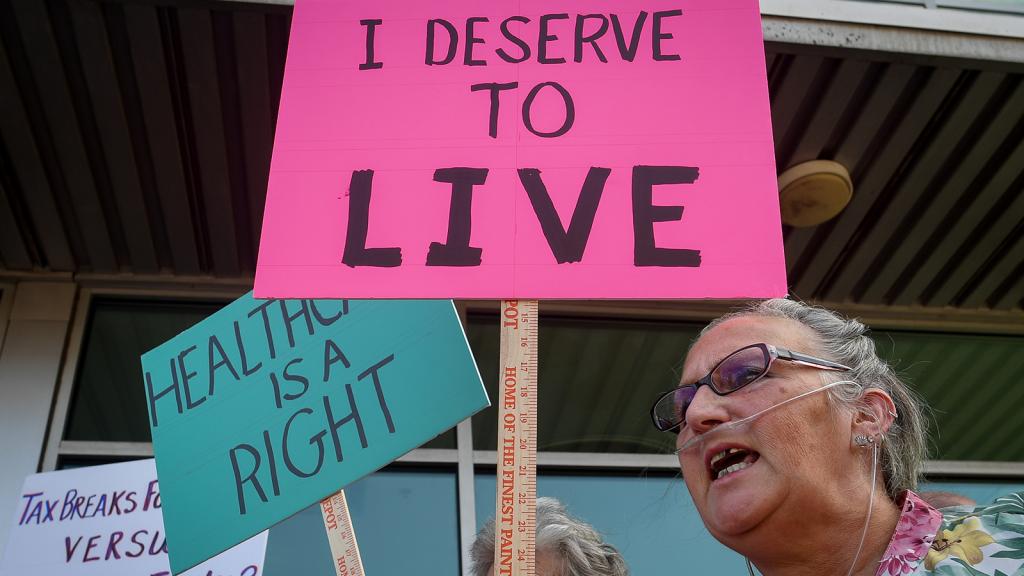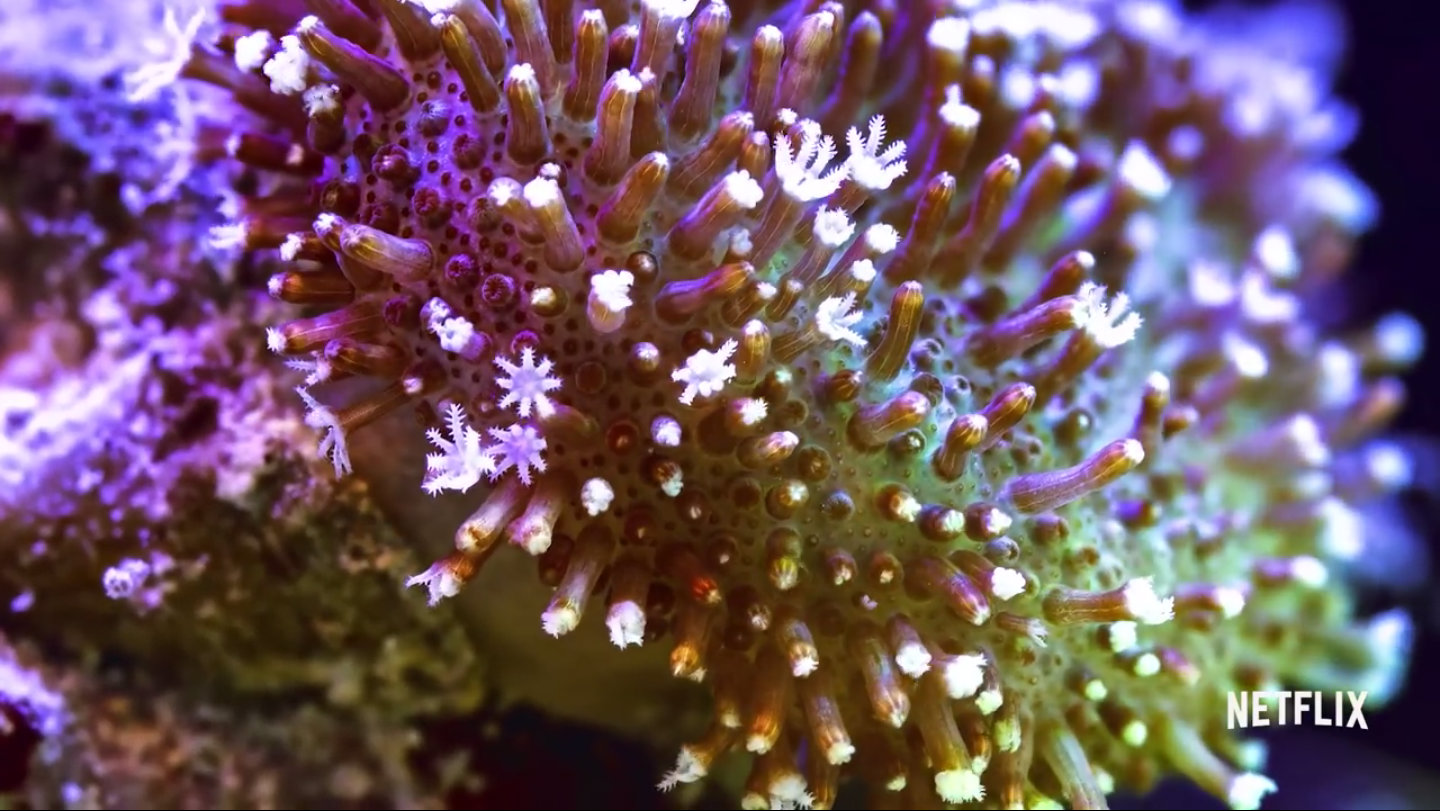Maybe the hardest part of conveying the scale and consequences of climate change is that transformation at the planetary scale can be hard to see. Carbon dioxide builds up invisibly in the atmosphere, seas inch inland year by year, and ecosystems continue to make their quiet shifts — big, slow changes that seem far from daily life.
Filmmaker Jeff Orlowski makes these vast transformations visible and urgent. In his first film, the Emmy award–winning Chasing Ice, Orlowski’s team followed National Geographic photographer James Balog on a mission to document disappearing glaciers. The video team captured the astonishing collapse of thousand-year-old landscapes — imperceptible in a single frame or a single day — in a series of timelapses captured in high-drama, high-risk Arctic conditions.
Orlowski’s team is back with an undersea sequel, Chasing Coral, premiering July 14 on Netflix. In it, the director takes aim at another subtle and earth-shaking change underway: the gradual collapse of coral reef ecosystems, triggered by rising ocean temperatures.
As reefs from the Caribbean to the South Pacific experienced an unprecedented three-year stretch of bleaching, the film crew — including Richard Vevers, a former ad man turned oceans advocate, and bright-eyed coral-lover Zackery Rago — set out to document the history-making event in a series of personal, urgent, and undeniable images. The footage they gathered, along with images from Chasing Ice, has even been entered into evidence in the lawsuit brought by 21 kids against the U.S. government for failing to address climate change.
We talked to Jeff Orlowski about how it feels to bear witness to a changing landscape, and where he hopes to end up once all this chasing is done.
Q. So this movie gave you a front seat to the bleaching of the Great Barrier Reef, which literally caused scientists documenting the damage to weep. How are you doing, anyway?
A.We never anticipated it getting anywhere close to as bad as it was. We thought that we would see bleaching, but we watched an entire ecosystem die. We have a bunch of friends who are scientists, and they’re getting therapy for depression related to the state of the planet. It’s a new niche of therapy, it seems: environmental counseling. I’ve been wondering about it myself.
People have been asking what we’re going to do next and it’s like, “We don’t want to do this.” There’s nothing about this that’s fun. I got into this to have fun adventures, and we’re just watching ecosystems collapse. It’s depressing.
Q. You’ve witnessed two of the biggest casualties of global warming — glaciers and coral reefs. Have you found any good coping mechanisms to deal with that?
A.I feel like I’ve gone through the processing of what the worst-case scenario looks like. I’ve visualized and accepted, OK, this is what the world could look like if we don’t take any action. We’re probably going to lose coral reefs on this planet very much within our lifetimes. We’re going to lose other ecosystems. I think in terms of coping, it’s just having to come to terms with how bad it is and wanting people to wake up so we can move on to solutions.
We know what the solutions are. If there were no alternative, if there were no option for a cleaner path ahead, I might feel differently. But since we have the solutions, and they’re so easy to implement — that’s where a lot of the pain comes from. We’re choosing a path of destruction, for no real benefit. And so it’s just a matter of trying to figure out how can we expedite getting to those solutions.
Q. How does an audience deal with that emotional arc?
A.There’s a huge challenge in finding the sweet spot for people who are aware versus unaware of climate issues. There are audiences who do get it and know what’s going on — and those audiences want hopeful stories. There’s another huge segment of the population that needs to be woken up to “Oh, there actually are big problems.”
Within the 90 minutes of the film, we’re trying to take people on a journey of magic and wonder to, ultimately, this shock — I don’t want to say fear, necessarily, but it is the cold hard slap of reality.
But there is hope. I am hopeful, our team is hopeful. If it wasn’t for the revolution in energy that we’re seeing, I don’t think I’d be as hopeful. It is the changing pricing structure on clean energy that’s going to get us out of this faster than anything.
Q. The plot follows the film crew as you grapple with the technological challenges of making this movie in the field. Why did you choose to put your crew at the center of the story?
A.For us, the question is: How do you get an audience to care about this stuff? As a filmmaker, what makes me feel emotional about this subject? For me, Zack [the young coral-loving cameraman on the team] was the best at communicating his passion and love for this ecosystem. And he was the one who was also the most affected by everything we were seeing. Zack’s personal story, his love and admiration for this ecosystem, and then the pain that he felt — you can relate to that. Anybody who loses something that’s very meaningful to them understands what that loss is like.
In part it’s a sad story, but at the same time we wanted to frame it as this inspirational story. All Zack wants to do now is teach kids about what he’s seen. He’s going to be out there on the road to take this to schools and to educate kids. And his message is not “fall in love with the ocean.” His message is: Go out and explore and study whatever it is that makes you happy and makes you fall in love with nature.
There’s something so pure and genuine about that. If you love bugs, go out there and study bugs — find out why they’re so fascinating, find out everything about them. In many ways he embodies for me the pure pursuit of science. It is curiosity, it’s wonder, it’s wanting to ask questions about how our planet works and to look for the answers.
Q. In both of the movies, perhaps especially this one, there were a lot of challenges to capture the images you wanted. Why was that such a struggle?
A.The particular challenge here was getting timelapses of things that were incredibly difficult to predict. Even if you go to a reef that you think is going to bleach, you don’t know what parts of the reef are going to bleach. When we were doing the glaciers, you could pick any glacier and once you install the camera, it’s constantly melting.
Plus, you can set up one camera to document the whole glacier. You can’t set up one camera to document an entire reef. We realized that the best way was to set up lots and lots of different camera positions on the same reef — that became a huge challenge when we had to do the timelapses by hand. The sand is changing every day, so where you’re putting your camera every single day is also changing. You’re shooting very close to subjects with wide-angle lenses, so just a little bit of movement changes the parallax in a huge way, making the timelapse really hard to stitch and align.
So the amount of time and effort into every single second of footage is exorbitant. I probably should calculate how much the rest of the film cost per second versus those timelapses, because it was ridiculous.
Q. Do you ever worry that in making an environmental documentary to begin with, you’re not reaching the people who don’t already know about this?
A.There are filter bubbles all over the place. Everybody naturally lives in their own self-selecting circle. And that’s film distribution by sheer definition — advertising to the people who might pay to see the thing. You don’t often get people to pay money to see something that they disagree with.
We’re doing very specific outreach in Florida and Georgia, and then moving on to Texas. For us, the attempt to find new audiences is all driven through word of mouth and community screenings. We’re doing shitloads of community screenings. Where we get the most outreach is through people getting their friends to see something. If they just see the trailer, they might not necessarily think, “Oh yeah, I have to see that film.” But if their friend from church says, “Hey, you need to watch this movie, come on over Friday and let’s watch it together,” then that’s a way in to new audiences.
Q. You said you got into filmmaking because you wanted to have adventures in cool places. So you’ve done Chasing Ice and Chasing Coral. What are you chasing next?
A.I am aware of probably half a dozen stories I could turn into a viable film. I don’t know if I have the emotional strength to tackle that yet. I need a bit of a break. Like I said, there’s no joy in watching ecosystems die.
Right now, I do feel that oceans are the frontlines of climate change. That’s where the heat is being observed most and that’s where the changes are happening the fastest. We didn’t even touch acidification in the film. It’s the biggest ocean issue coming our way, but it’s hard to visualize. Visual evidence has been the connective tissue between these two films. Our hope is that if you can address the bleaching crisis now and solve that, you also by proxy solve the acidification problem.
Q. And then you don’t have to figure out how to film acidification?
A. Exactly. Stop global warming and we don’t have to visualize the oceans dying from acidification.



